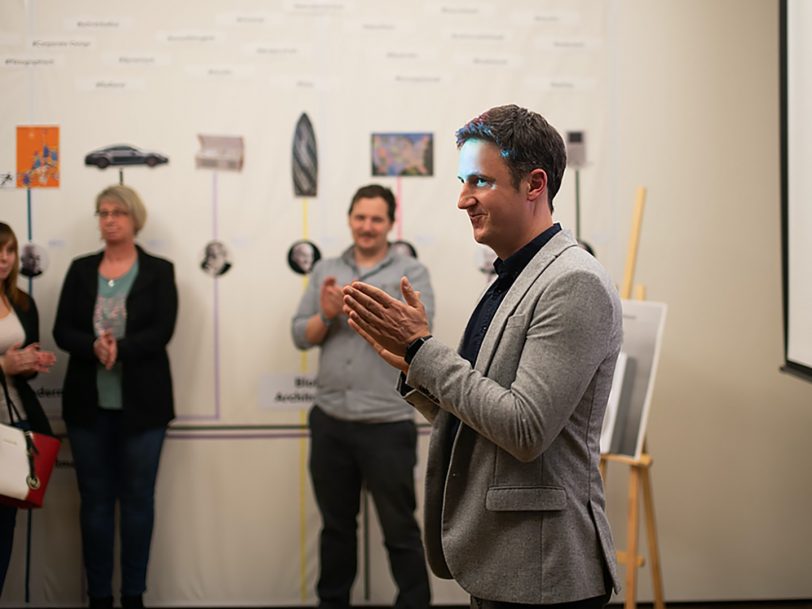Be brave and curious – gain experience and as many of them as possible!
In my courses, I procure enjoyment and excitement for, and empower my students to express their personalities with great design. The appreciation of one’s individual style can cultivate both the acceptance for differing design approaches as well as procuring a culture of togetherness. I strongly believe that one can only exceed in a field when living and breathing it wholeheartedly. It is my duty to find this passion within my students in a team effort – to subsequently nurture their passion specifically in these fields.

Vernissage
graduate show
At the Media University of Applied Sciences in Frankfurt in the in the courses B.A. Graphic Design and Visual Communication and M.A. Communication Design and Creative Strategies.
Universities
As of now, I teach as a professor at the Media University of Applied Sciences in Frankfurt and as Head of Studies I am in charge of the master’s course Communication Design and Creative Strategies. My research interest lies in the area of social innovation. As a scientific advisor, I support the Research and Development Lab of the Virtual Design study study at the University of Applied Sciences Kaiserslautern.
Learning Concept
From a neuroscientific point of view, creativity is a natural human ability – learning is based on positive experiences. My job as a professor is to create an inspiring creative scope for teaching and research. Because only the practical and direct examination of a learning content enables effective and meaningful learning.
Through project-based didactics, which above all is fun and arouses curiosity, I understand my role as a coach or mentor, give impulses, orientation and support personal development.
“Learning is experience. Everything else is just information.”
– Albert Einstein
Courses
- Interface-, Interaction- and User Experience Design
- Service Design & Design Thinking
- Social Design
- Corporate Identity & Corporate Design
- Fundamentals of Design
- Communication and Management Techniques
- Expressive Typography
- Meditation and Mindfulness for Social and Personal Competencies
- Art & Design History
Research focus
- Social Innovation
- Participatory Design
- Design Futuring

Interface-, Interaction- and User Experience Design
The central subject of the course lies in the design of various types of interfaces. Students engage with semantic, ergonomic and cognitive aspects, together with coding, information structure and formal qualities. At the same time, the course is set to address fundamentals even before practical development. As one would do in professional working environments, the core value and target groups of a project need to be defined to effectively plan further development steps. My students develop mood boards, navigational elements, information architecture and, through prototypes, advance towards user-oriented design implementation.
Service Design & Design Thinking
When looking to solve complex tasks, it is common for people to look for technological possibilities as a universal remedy – while letting the user’s actual needs fall from their view. The method of service design and design thinking assists in consistently keeping the interests and desires of the user locked in focus: In this course, students learn to gain an understanding of their target group and their environment in order to design, test and improve prototypes on this basis. This is how innovative products, services or experiences are created that have the potential to generate added value for people and the environment.
Social Design
The course „Social Design“ is addressing today’s fundamental societal shift and the associated requirements to a sustainable and ecological behavior and social commitment. Design can have a substantial effect, as long as it exceeds mere aesthetic value: With a strong practical relevance and appreciation for experimentation, students learn to combine social and creative competences into a forward-thinking understanding of design. This knowledge empowers students to realize socially relevant projects in everyday working environments and create ideas for a better future.
Corporate Identity & Corporate Design
The appearance of a brand is always a reflection of its values and an expression of its strategic positioning. Every product needs a clear design – a brand specific design language. It should be consistent at all touchpoints. These are currently more complex than ever before. In the Corporate Identity course, students develop modular design systems and concepts that are holistic and can be used in a modular manner. You will learn to build brands strategically, to facilitate the process of their development and to use technological tools in addition to creative means. This creates design solutions that can be used flexibly depending on the medium and convince through a consistent cross-media design language.
Fundamentals of Design
With due respect to the power of intuition: Design follows basic principles. For those who have decided to engage with the studies of design, the course “Fundamentals of Design” offers the essential basics to evaluate the fruit of creative work. We engage with typography, composition, classification systems, contrasts and the incisiveness of reduction – along with the question of how creative resources and tools can be accessed and utilized effectively. Further, we observe the specific requirements of print media and online applications.
Communication and Management Techniques
In the course of working as a designer, one is not only measured by one’s design skillset: Everyday work life requires essential project management, presentation and communication skills, as well as a basic understanding of business administration. Responsible design training therefore includes explaining typical processes in everyday agency life, understanding and being able to apply problem-oriented design processes on the company and agency side.
Expressive Typography
We are accustomed to use letters as a neutral tool for information transmission: Yet, when letters merge into words, the imagery connected to these words are created in our minds alone. In the course “Expressive Typography”, students experiment with the possibilities of overcoming this strict separation of characters and content. Beyond the baseline functionality of “being read”, characters can superimpose emotionalizing and associative layers on the written word, using the exterior form as a tool to emphasize on the content matter.
Art and Design History
Design is always taking place in a social context. A closer look on the works of art and design is, in a way, the act of deciphering the circumstances of its time. The module “Design History” accordingly teaches students the appropriate methods. By reference to objects of graphic and product design since the beginning of the 19th century, this course trains the eye on contents, materials and production processes to coherently describe, analyze and interpret creative works with confidence. Students gain a general understanding of the definition of great and, more importantly, lasting design.
Meditation and Mindfulness for Social and Personal Competencies
People find it easier to cope with difficult challenges in a playful simulation rather than “real life” situations. Based on this insight, the learning concept “PressPause2Play” empowers students to apply skills learned in playful setting onto everyday challenges, as through fusing awareness and creativity, they gather mental strength and inner calm, turning challenges into opportunities. The training method PressPause2Play combines traditional mindfulness training with scientific insights from sport science, creativity studies and psychology.

„My perception has changed, beyond mere design and I am now much more aware of my environment.“ (Feedback after the Social Design course).
Michelle Wagner
B.A. student Graphic Design and Visual Communication. 1. Semester. Module project workshop.
Volunteering
My voluntary activities in design juries, initiatives and associations complements my research, teaching and endorsement of young talents, creating interdisciplinary exchange and valuable synergies.


